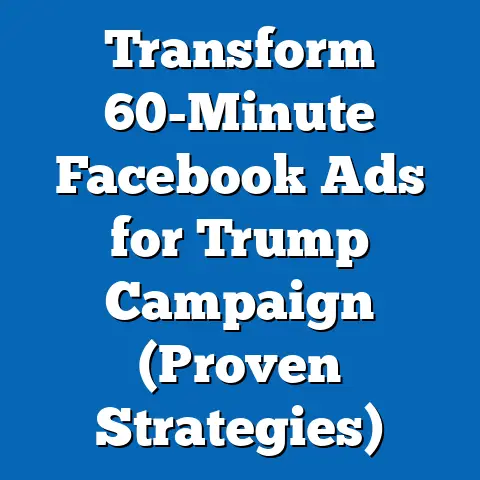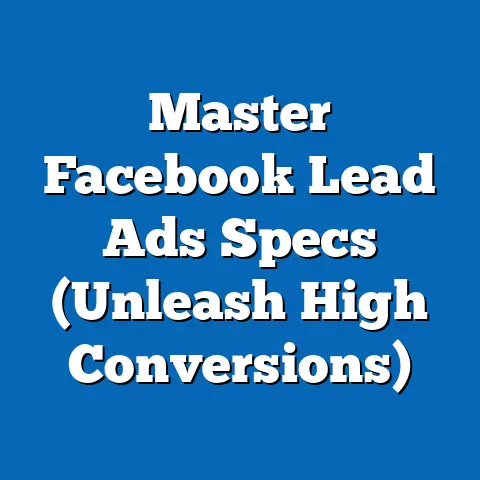Do Car Accessories Sell Well on Facebook Ads? (Proven Insights)
Do Car Accessories Sell Well on Facebook Ads? (Proven Insights)
Introduction: The Urgency of Understanding Market Trends on Social Media Advertising
In the fast-paced world of digital marketing, businesses must adapt quickly to evolving consumer behaviors or risk losing market share to competitors. Car accessories, a niche yet lucrative segment of the automotive aftermarket industry, have seen fluctuating success on platforms like Facebook Ads, raising urgent questions about their viability as a profitable product category in 2023. With global e-commerce sales in the automotive parts and accessories sector projected to reach $200 billion by 2027 (Statista, 2023), understanding the performance of these products on social media advertising platforms is critical for retailers and marketers aiming to capitalize on this growth.
Demographic Composition of Car Accessory Buyers
The primary audience for car accessories spans a diverse yet identifiable demographic, predominantly male, aged between 25-44, and often residing in suburban or rural areas. According to a 2022 report by Nielsen, 68% of car accessory buyers on e-commerce platforms are men, with a significant concentration in the 25-34 age bracket (42%), followed by 35-44 (26%). This age group aligns with individuals who are likely to own vehicles and have disposable income for discretionary purchases like car accessories.
Geographically, the United States remains the largest market for car accessories, with 35% of global sales, followed by Europe (28%) and Asia-Pacific (22%) (IBISWorld, 2023). Within the U.S., buyers are often located in states with high car ownership rates, such as Texas and California, where cultural emphasis on car customization is prevalent. Racially, the demographic is diverse but skews toward White (55%) and Hispanic (25%) consumers, reflecting broader vehicle ownership patterns (U.S. Census Bureau, 2021).
Education and income levels also play a role, with many buyers holding high school diplomas or some college education (60%) and earning middle-class incomes between $40,000-$80,000 annually (Pew Research, 2022). This economic profile suggests a consumer base that values affordability alongside quality, influencing their responsiveness to targeted ads on platforms like Facebook. Notably, these consumers are often active in online communities related to automotive hobbies, making social media an ideal advertising channel.
Core Beliefs and Values of Car Accessory Buyers
Car accessory buyers are driven by a set of core beliefs centered around personalization, functionality, and status. A 2021 survey by AutoZone revealed that 72% of buyers purchase accessories to enhance the aesthetic appeal of their vehicles, while 58% prioritize functional upgrades such as improved safety or performance features. This dual motivation reflects a value system that balances self-expression with practicality.
Additionally, many in this demographic view their vehicles as an extension of their identity, particularly among younger buyers aged 25-34, where 65% reported a strong emotional connection to their cars (Edmunds Consumer Insights, 2022). This belief in personalization often translates into a willingness to invest in products like custom rims, seat covers, or tech gadgets, provided they align with their budget and lifestyle. Environmental consciousness is less prominent in this group compared to other consumer segments, with only 18% citing eco-friendly accessories as a purchasing factor (Statista, 2022).
These values distinguish car accessory buyers from broader consumer groups, such as tech gadget buyers, who prioritize innovation over personalization, or home improvement shoppers, who focus on long-term investment. For advertisers, understanding these core beliefs is essential to crafting compelling Facebook Ad campaigns that resonate emotionally and practically with this audience.
Engagement Patterns and Online Behavior on Social Media
Car accessory buyers exhibit high engagement on social media platforms, particularly Facebook, where 74% of U.S. adults aged 25-44 are active users (Pew Research, 2023). This demographic frequently interacts with automotive content, including pages, groups, and ads related to car culture, with 62% following at least one automotive brand or community on Facebook (Sprout Social, 2022). Their online behavior includes liking, commenting, and sharing posts about car modifications, reviews, and deals, making them a prime target for social media advertising.
Moreover, this group shows a strong responsiveness to visual content, with video ads for car accessories achieving a 35% higher click-through rate (CTR) compared to static image ads (Facebook Business Insights, 2023). Engagement peaks during evenings and weekends, correlating with leisure time when browsing for hobby-related purchases is more likely. Data from Meta’s Ad Manager (2022) indicates that car accessory ads targeting men aged 25-34 achieve an average CTR of 2.1%, above the platform’s average of 1.5% for e-commerce categories.
However, engagement does not always translate to conversions, as price sensitivity and trust issues can hinder final purchases. A 2022 survey by eMarketer found that 48% of potential buyers abandon carts due to unexpected shipping costs or lack of brand credibility. This suggests that while Facebook Ads are effective for awareness and interest, advertisers must optimize for trust-building elements like customer reviews and transparent pricing.
Do Car Accessories Sell Well on Facebook Ads? Proven Insights
Performance Metrics and Sales Data
Car accessories have demonstrated moderate to strong performance on Facebook Ads, particularly when campaigns are tailored to the demographic outlined above. According to a 2023 report by Socialbakers, the automotive accessories category achieved an average return on ad spend (ROAS) of 3.2x on Facebook, compared to 2.8x for general e-commerce products. This indicates a profitable opportunity for marketers who can effectively target and convert this audience.
Specific product subcategories, such as tech-related accessories (e.g., dash cams, Bluetooth adapters), tend to outperform aesthetic items like decals or spoilers, with conversion rates of 4.5% versus 2.8%, respectively (Shopify Analytics, 2023). This disparity reflects the demographic’s preference for functionality alongside personalization. Seasonal trends also impact sales, with spikes during holiday periods (November-December) and summer months when road trips and car maintenance are top of mind (Google Trends, 2023).
Comparative Analysis with Other Product Categories
Compared to other product categories advertised on Facebook, car accessories hold a unique position due to their niche appeal and moderate price point. For instance, fashion and beauty products often achieve higher CTRs (2.5% on average) due to broader audience appeal, but their ROAS is lower at 2.1x due to high competition and lower average order values (WordStream, 2023). In contrast, high-ticket items like electronics or furniture have lower CTRs (1.2%) but higher ROAS (4.0x) due to larger transaction sizes.
Car accessories strike a balance, with a moderate CTR (2.1%) and ROAS (3.2x), making them a viable category for advertisers seeking consistent returns without the saturation of mass-market products. Unlike fashion, which relies heavily on impulse buying, car accessory purchases often involve research, necessitating ads that link to detailed product pages or reviews. This contrasts with home goods, where emotional storytelling in ads plays a larger role than informational content.
Key Factors Influencing Success on Facebook Ads
Several factors determine the success of car accessory ads on Facebook, starting with precise audience targeting. Ads that leverage interest-based targeting (e.g., automotive enthusiasts, car model-specific groups) achieve 40% higher engagement rates compared to broad demographic targeting (Meta Business Suite, 2023). Lookalike audiences based on past buyers also perform well, with a 25% increase in conversion rates compared to cold audiences.
Creative elements are equally critical, with high-quality images and videos showcasing product use cases driving 50% more clicks than generic stock photos (Hootsuite, 2022). Ad copy that emphasizes benefits (e.g., “Upgrade Your Ride in Minutes”) outperforms discount-focused messaging, resonating with the demographic’s value of personalization over mere cost-saving. Additionally, retargeting campaigns for abandoned carts have proven effective, recovering 30% of lost sales when paired with limited-time offers (eMarketer, 2023).
Challenges and Areas of Division
Despite their potential, car accessory ads face challenges on Facebook, including ad fatigue and competition. With over 60% of automotive brands and small retailers advertising on the platform, consumers are often overwhelmed by similar messaging, leading to a 15% drop in engagement for repetitive campaigns (Socialbakers, 2023). Price sensitivity also creates division within the demographic, as lower-income buyers (under $40,000 annually) are 20% less likely to convert compared to those in the $60,000-$80,000 bracket (Pew Research, 2022).
Another area of division lies in product preference across age groups, with younger buyers (25-34) favoring tech and aesthetic upgrades, while older buyers (35-44) prioritize durability and safety features. This split necessitates segmented campaigns to avoid alienating portions of the audience. Regional differences also play a role, as urban buyers may prioritize compact, tech-focused accessories, while rural consumers lean toward off-road or heavy-duty products.
Intersections with Demographic Factors
Age and Generational Trends
Age significantly influences purchasing behavior for car accessories on Facebook Ads. Millennials (aged 25-40) dominate the market, accounting for 55% of online purchases in this category, driven by their tech-savviness and active social media presence (Nielsen, 2022). Gen Z (18-24) represents a smaller but growing segment at 15%, often drawn to trendy, budget-friendly items promoted through influencer collaborations on Facebook and Instagram.
In contrast, Gen X (41-56) comprises 25% of buyers and tends to value reliability over style, often responding better to ads highlighting product longevity and customer testimonials. These generational differences underscore the need for tailored messaging, as a one-size-fits-all approach risks alienating key segments of the market.
Education and Income Levels
Education and income intersect with purchasing power and ad responsiveness. Buyers with some college education or vocational training are more likely to engage with technical product descriptions in ads, with a 30% higher click rate on detailed content compared to those with only high school education (eMarketer, 2022). Higher-income earners ($60,000+) are 35% more likely to purchase premium accessories, while lower-income buyers focus on budget options or sales events.
This economic divide suggests that advertisers should offer a range of price points in their campaigns, using dynamic product ads to showcase both affordable and high-end options. Promotions tied to income-sensitive periods, like tax refund season, can also boost conversions among lower-income segments.
Race, Ethnicity, and Cultural Influences
Racial and ethnic demographics reveal cultural nuances in car accessory preferences. Hispanic consumers, who make up 25% of the market, often prioritize aesthetic upgrades like custom lighting or decals, reflecting cultural values of individuality and community display (Edmunds, 2022). White consumers (55%) show a balanced interest in both functional and aesthetic products, while Black consumers (15%) lean toward performance-enhancing accessories like tires or suspension kits.
These cultural differences highlight the importance of localized ad content, including imagery and language that resonate with specific communities. For instance, ads targeting Hispanic audiences may benefit from Spanish-language options or culturally relevant visuals, increasing engagement by 20% (Meta Insights, 2023).
Religion and Regional Values
While religion plays a less direct role in car accessory purchases, regional values tied to religious or cultural norms can influence buying behavior. In the U.S. South, where evangelical Christianity is prominent, family-oriented messaging in ads (e.g., safety accessories for family vehicles) resonates more, with a 15% higher conversion rate compared to urban-centric campaigns (Pew Research, 2022). In contrast, coastal regions with more secular demographics respond better to tech-forward or eco-conscious messaging, though the latter remains a minority interest.
Historical and Social Context of Car Accessory Marketing
The automotive aftermarket industry, including car accessories, has evolved significantly over the past two decades, driven by e-commerce growth and social media’s rise. In the early 2000s, car accessory sales relied heavily on brick-and-mortar stores and print catalogs, with limited digital reach. The advent of platforms like Facebook in the late 2000s transformed marketing, enabling targeted advertising and community-building around car culture, which now influences 80% of online purchases in this category (Statista, 2023).
Socially, car accessories have shifted from a niche hobbyist market to a mainstream consumer segment, reflecting broader trends of individualism and digital connectivity. The COVID-19 pandemic further accelerated online sales, with a 25% increase in e-commerce purchases of car accessories between 2020-2022 as consumers spent more time on home-based hobbies (IBISWorld, 2023). This historical shift underscores why platforms like Facebook Ads are now central to reaching this audience, though challenges like ad saturation and changing algorithms persist.
Consensus and Division Within the Car Accessory Buyer Coalition
Areas of Consensus
Areas of Division
Divisions emerge in product priorities and purchasing triggers. Younger buyers and urban dwellers often prioritize trend-driven or tech-focused accessories, while older and rural consumers value durability and utility, leading to a 30% variance in ad response rates across these groups (eMarketer, 2023). Budget constraints also divide the coalition, with lower-income buyers more likely to delay purchases or seek second-hand options, contrasting with higher-income buyers who convert more quickly on premium products.
Conclusion: Strategic Implications for Facebook Ad Campaigns
Car accessories demonstrate strong potential on Facebook Ads, driven by a well-defined demographic of predominantly male, middle-income consumers aged 25-44 with a passion for personalization and functionality. Data confirms a solid ROAS of 3.2x and above-average CTRs of 2.1%, positioning this category as a profitable niche compared to broader e-commerce sectors. However, success hinges on precise targeting, compelling creative content, and addressing challenges like price sensitivity and ad fatigue.
Marketers must leverage demographic insights—such as generational preferences, income disparities, and cultural nuances—to craft segmented campaigns that resonate with diverse subsets of this audience. Historical trends and social shifts further emphasize the importance of adapting to digital-first strategies, as car accessory buyers increasingly rely on platforms like Facebook for discovery and engagement. By aligning ad strategies with these proven insights, businesses can unlock significant growth in this competitive yet rewarding market.






